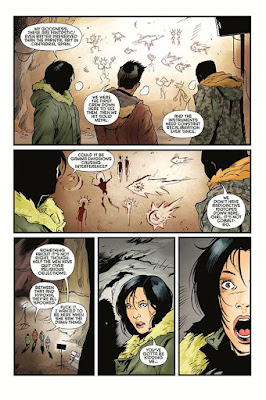Writer: Justin Giampaoli
Art: Andrea Mutti
Dark Horse $3.99
Jo S: Dark Horse are placing themselves firmly into the mainstream of comics with big title successes such as Umbrella Academy, Hellboy, Stranger Things and Black Hammer on their roster, along with the Berger Books imprint (curated by Karen Berger of Vertigo fame) providing some more ‘out there’ but accessible choices. Released this week then comes Starship Down, aimed square at fans of the 'sci' part of sci-fi, and packed tight with elements that tick boxes on my coming-back-for-more list.
Anthropologist Dr Jocelyn Young has been called in to a top secret site, apparently for her opinion on a set of ancient cave paintings but, as she is choppered in to the remote Siberian mining facility where the dig site is located, it becomes evident that there is much more to it than the initial briefing.
The book has ambitious scope, and Andrea Mutti’s art labours hard to evoke that from the first page, as a USAF helicopter swoops over a berg-strewn ocean, a military fleet to evidence this is a tense geopolitical context. The Hellmouth-like cobalt mine plunging deep into the frozen earth is dramatic and Mutti manages to confer the giant scale of the construct, later using vertical page deep panels to give the sense of the towering height of the internal tunnels of the mine and caves. His illustrative style really made his recent stint on the Infinite Dark series work for me: the concept in there was huge, dealing with the heat death of the universe and how the human race would adapt to their imminent entropic destruction. Mutti conveys both the hugeness of space and the tiny details of a near emotionless face with equal skill, and he seems therefore to be a great choice for this. The design of the cave paintings used is cute but feels credible - there’s a strong sense of Mutti having done his homework, with echoes of the Nazca lines among other real ancient daubings.
 This huge scope of ambition doesn’t stop at the art though: Justin Giampaoli dives right in off the bat and cracks through a list of the pressures and complications which Young will face in her challenge here. Given the title of the series, it’s no spoiler to suggest that there may be alien technology involved, and hence security on the project has been clamped down tight. As the only female character, Young is required to be a highly educated scientist (some of her back story is eked out confirming this), but also to be an effective project manager, a linguist (would it really be normal for an American anthropologist to be fluent in Russian to the point of identifying regional accents? Perhaps further backstory will explain this) and to firmly fend off manhandling by security staff. Giampaoli plunges right into the conversation regarding the reaction to the discovery of possible alien technology by introducing a frosty Catholic Cardinal to the narrative: his disgust at Young’s profession as a cultural anthropologist hammers swiftly home that discoveries made at this site will not land easy with the rest of the world.
This huge scope of ambition doesn’t stop at the art though: Justin Giampaoli dives right in off the bat and cracks through a list of the pressures and complications which Young will face in her challenge here. Given the title of the series, it’s no spoiler to suggest that there may be alien technology involved, and hence security on the project has been clamped down tight. As the only female character, Young is required to be a highly educated scientist (some of her back story is eked out confirming this), but also to be an effective project manager, a linguist (would it really be normal for an American anthropologist to be fluent in Russian to the point of identifying regional accents? Perhaps further backstory will explain this) and to firmly fend off manhandling by security staff. Giampaoli plunges right into the conversation regarding the reaction to the discovery of possible alien technology by introducing a frosty Catholic Cardinal to the narrative: his disgust at Young’s profession as a cultural anthropologist hammers swiftly home that discoveries made at this site will not land easy with the rest of the world.
Giampaoli has also clearly researched hard for this project: the complex ‘here comes the science’ talk is logical and credible and his capability with historical reversioning is already documented: his Rome West project, written with Brian Wood and also illustrated by Mutti, looked at an alternative history of the States, a ‘What If… The Romans Had Colonised America First?’
There is certainly some DNA shared with Warren Ellis and John Cassaday's Planetary amongst other comics and movies in the genre, and it feels like something of a classic sci-fi disaster movie: if you enjoy the pattern of a good ‘scientist discovers evidence of alien life on Earth, complications ensue’ then this may well be the book for you, with plenty of nice touches in this first issue to make it feel different and promising. Referring to the site’s location by its latitude and longitude immediately gave the impression that we’re truly in the middle of nowhere, the non-clichéd acceptance of the scientist’s authority by the military staff (calling in scientists and then ignoring their opinion - why roll out that trope in a story when that just wouldn’t happen in real… oh...), the confluence of science ancient, modern and alien was handled nicely and the interplay between scientific, military and religious representatives when faced with evidence incongruous to their existing beliefs was delivered without sensationalism, in a way that will certainly bring me back in for issue #2; definitely a first issue with the potential to grow into a new sci-fi mainstay. 8/10


No comments:
Post a Comment